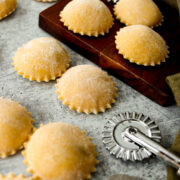Description
There's nothing quite like the satisfaction of biting into a pillowy homemade ravioli—freshly made egg pasta enveloping a creamy, cheesy filling, all smothered in a vibrant, homemade marinara sauce. This is comfort food at its finest—a dish that brings family together at the table and makes everyone go, “Yummy!” Whether you’re planning a special family dinner or meal-prepping for busy weekdays, this ravioli recipe is a labor of love that’s both fun to make and utterly delicious.
Ingredients
For the Cheese Filling:
- 1 cup whole milk ricotta cheese
- 1/2 cup grated Parmesan cheese
- 1 egg yolk (helps bind the filling)
- Salt and pepper, to taste
- A pinch of ground nutmeg (optional, for warmth)
- Chopped fresh herbs (basil or parsley), optional
Instructions
- Make the homemade egg pasta dough recipe.
- After the dough has rested, divide it into 2 or 3 equal pieces to make it easier to work with. Keep the pieces you aren't using covered to prevent them from drying out.
- If you have a KitchenAid pasta attachment, set it up according to the manufacturer's instructions. Dust your pasta roller with flour to prevent sticking, then feed one piece of dough through the machine at the widest setting. Fold the dough in half, dust lightly with flour, and feed it through again. Repeat this process 3-4 times to develop the dough's smooth texture, gradually reducing the thickness until you achieve a thin sheet (about 1/16 inch thick). Aim for a uniform thickness across the entire sheet if you're rolling by hand.
- Place the rolled-out pasta sheets on a lightly floured surface or large sheets of parchment paper. Cover them with a clean kitchen towel while you work on the filling to prevent them from drying out.
3. Preparing the Cheese Filling
- Combine the whole milk ricotta, grated Parmesan, and egg yolk in a mixing bowl—season with salt, pepper, and a pinch of nutmeg. If using, fold in chopped fresh herbs such as basil or parsley. The filling should be smooth, creamy, and well-blended. Taste a bit (if you dare!) to ensure proper seasoning.
- Transfer the cheese mixture into a piping bag fitted with a small round tip for ease of filling your ravioli. This will allow you to deposit neat, controlled dollops of filling onto your pasta sheet. If you don't have a piping bag, you can spoon the mixture carefully, but a piping bag makes the process much faster and cleaner.
4. Assembling the Ravioli
- Please lay one of your pasta sheets flat on a lightly floured surface. Using the piping bag, place small dollops (about one teaspoon each) of cheese filling onto the pasta sheet, spacing them about 2 inches apart. Be careful not to overfill, or your ravioli may burst open during cooking!
- Gently lay a second pasta sheet over the top of the first one, taking care not to press out the filling. Using your fingers or a small rolling pin, lightly press around each dollop of filling to ensure there are no air pockets and that the two sheets are sealed together.
- Cut out individual ravioli squares or rounds using a sharp knife, pizza cutter, or ravioli cutter. If you have a ravioli stamp or mold, now is the time to use it! Press the edges firmly with your fingers or a fork to secure the filling inside.
- Once all your ravioli are cut, arrange them on a parchment-lined baking sheet. If you're cooking them immediately, you're ready for the next step. Otherwise, if you're freezing them for later, let them freeze individually for 1-2 hours before transferring them to a freezer-safe bag or container. Properly frozen ravioli can last for up to three months.
5. Cooking Your Ravioli
- Fill a large pot with salted water and bring it to a boil. The salt is crucial—it helps season the pasta as it cooks and prevents sticking.
- Gently drop a few ravioli into the boiling water. They should float to the surface within 3-5 minutes, indicating that they are cooked through. Be careful not to overcrowd the pot—cook in batches if necessary. Use a slotted spoon to remove the ravioli, letting any excess water drain off.
- Serve your freshly cooked ravioli with a generous ladle of homemade marinara sauce, a sprinkle of extra Parmesan, and a few fresh basil leaves for garnish. Enjoy the soft, pillowy texture and the rich, cheesy filling that delights every bite.
Notes
This is my favorite rolling pin for shaping raviolis and my favorite ravioli cutters.
